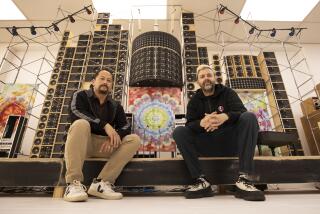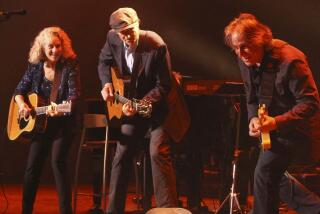Rock Roots on Display Loud ‘n’ Clear
In the Orange County of a half-century ago, the John Birch Society was thriving and critics of rock ‘n’ roll warned that the music was a communist plot to corrupt teenagers.
Man, were they clueless to what was happening in Orange County’s hip and rocking underground.
Locally made Fender and Rickenbacker guitars carried rock to the rest of the world and, some say, contributed to the downfall of European communism.
Rock music survived the doomsayers and moralists, and the genre’s early path through Orange County is on exhibit at the Fullerton Museum Center through May.
The show, “The Orange Groove: Orange County’s Rock ‘n’ Roll History,” features the local artists most associated with rock ‘n’ roll -- the blue-eyed soul duo Righteous Brothers and surf-guitar originator Dick Dale.
But tribute is also given to Fullerton native Leo Fender and Santa Ana resident F.C. Hall, whose Fender and Rickenbacker guitars influenced virtually every rock musician since the early 1950s.
With his innovative electrical Broadcaster and Telecaster guitars, Fender, a country music fan, monopolized the rock music scene in the 1950s. His sleek Stratocaster -- inspired by Space Age travels into the stratosphere -- became the next standard.
The upbeat jingle jangle of the Rickenbacker guitar, favored by Pete Townshend of the Who and the Byrds’ Roger McGuinn, became a signature sound of the 1960s, like the whomp whomp downbeat of a Huey helicopter’s rotor blades in Vietnam. Thanks to Armed Forces Radio, GIs got to hear both.
The largest displays focus on Righteous Brothers Bill Medley (Santa Ana) and the late Bobby Hatfield (Anaheim) and Dale, who hung out in Surf City. Medley and Hatfield released their first hit single, “Little Latin Lupe Lu,” on the Garden Grove-based Moonglow label. Phil Spector, who is awaiting trial in Los Angeles on suspicion of murder, signed the pair to his Philles label after that and produced their first No. 1 hit, “You’ve Lost that Lovin’ Feelin’.”
Dale, known as the king of the surf guitar, and his Del-Tones defined the Orange County music scene in the early 1960s. The group’s weekend gigs at the Rendezvous Ballroom on the Balboa Peninsula attracted teens from across Southern California despite a dress code. Dale’s growing success even inspired surf bands in such places as Indiana and further promoted the popularity of Fender guitars.
The exhibit also recognizes the Chantays, a Santa Ana garage band that found its surf-inspired instrumental “Pipeline” climb to No. 3 on the charts in May 1963.
The exhibit was almost more than Chas Balun, 56, could handle. The Orange County native, a graphic artist, experienced the local music scene in the 1960s.
“This brings back good vibes from the ‘60s. What this [exhibit] does is legitimize rock ‘n’ roll as a true art form,” said Balun, wearing a Jimi Hendrix T-shirt. “Rock ‘n’ roll changed people’s lives. It gave us hope and reason to live in a time that was full of turmoil. It gave miscreants and outcasts an outlet to contribute something meaningful and lasting to society.”
The exhibit also includes displays about the county’s contribution to folk music and folk rock, including Jackson Browne, who grew up in Fullerton and whose songs of social conscience are staples of almost every protest group.
Other big names came to Orange County with songs about drugs and free love, including the likes of Grace Slick and the Jefferson Airplane who played at such local venues as the Golden Bear in Huntington Beach and the Retail Clerks Union Hall in Buena Park. The exhibit notes that Sonny and Cher appeared as “Caesar and Cleo” at the retail clerks hall early in their career.
One display chronicles the brief but colorful career of the Avengers VI, a 1960s Anaheim surf band that recorded “Real Cool Hits,” an album on the Anaheim-based Mark 66 label. The record company’s promoter tried to sell the album from Good Humor ice cream trucks.
The idea fizzled, but the album is still available online.


